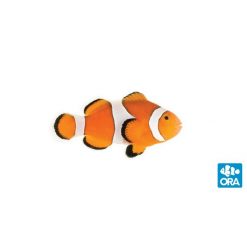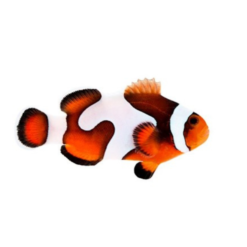About the ORA Pearl Eye Two Band Clarkii Clownfish Captive-Bred
Care Level: Easy
Temperament: Peaceful
Reef Safe: Yes
Diet: Omnivore
Max Size: 4 inches
Minimum Tank Size: 10 gallons
The Pearl-Eye Two-Band Clownfish is a member of the Clarkii complex. They are mustard yellow to rusty orange in color with 2 white bars located on the head and mid-body. There is no band on the base of the large lyre tail. They grow to a maximum size of around 4 inches. A. bicinctus will become territorial as they mature so more than 2 fish per tank is not recommended.
They have a very attractive swimming pattern that makes them look as if they were “bobbing up and down” continuously. This feature has won them a spot among hobbyists of all levels as one of their favorite clownfish.
The Two-Band Clownfish is found in the Red Sea and is rarely seen in the aquarium trade. These fish can live for more than 20 years in captivity.
The Clarkii Clown, a.k.a. Sebae Clown, is a beautiful Clownfish that has a higher profile than most clownfish. These Clowns have a yellow-orange body with vertical white bands.
They do extremely well in the aquarium and are very peaceful. These fish will accept most fish foods and are perfect for reef tanks. More than one can be kept in the same aquarium.
The Clarkii does not need an Anemone to survive, but will accept many different Anemones as its host, including corals. It is probably the least picky when it comes to Anemones and will accept Carpet Anemones, Bubble Tip Anemones, Sebae Anemones, or Long Tentacle Anemones as its host.
Clownfish have a very distinct swimming motion that is different from most fish. This is likely passed on through their genetic makeup from centuries of wiggling within the tentacles of Anemones. As the Clownfish wiggles within the stinging tentacles the Anemone’s mucus is likely smeared over the Clownfish’s body, which then protects it from additional stings.
In the wild they live in small groups with one large dominant female, one smaller sexually active male, and a handful of smaller males and juveniles. When the female is lost the largest male will then change sex and become the dominant female with the other Clowns moving up the ladder behind it.
| Size | 1-2 inches |
|---|














